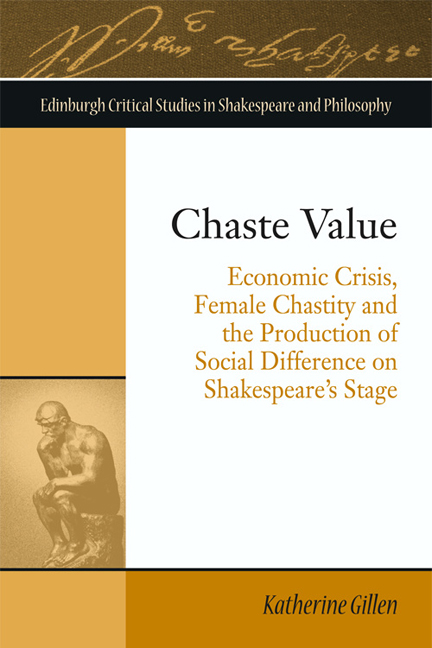 Chaste Value
Chaste Value Published online by Cambridge University Press: 22 December 2017
Antitheatrical tracts often depict the theatre as a brothel that commoditises people and sells a debased product. By extension, the playwright is figured as a bawd and the player as a prostitute, selling his body for money and enticing audiences with deceptive artifice. Like the brothels neighbouring the public theatres, theatrical displays are cast as dangerously seductive, both in Puritan antitheatrical literature and in policy documents aimed at mitigating the theatre's potential threat to public health and morality. As Stephen Gosson writes in The Schoole of Abuse (1579), plays feature ‘melody to tickle the eare; costly apparel, to flatter the sight; effeminate gesture, to ravish the sence; and wanton speache, to whet desire too inordinate lust’. The theatre assaults audience members with, in the language of the Lord Mayor's 1597 petition to suppress the theatre, its ‘unchaste matters, lascivious devices, shiftes of cozenage, & other lewd & ungodly practices’. As John Rainolds further asks, ‘who can deny that men are made adulterers and enemies of chastitie by coming to such plaies?’
For Gosson and his fellow antitheatricalists, the theatre not only caters to prostitutes and other sexual reprobates, but its very medium resembles the prostitute's self-presentation, with its appealing exterior belying a corrupt interior. Dramatists, Gosson alleges in Plays Confuted in Five Actions (1582), ‘falsifie, forge, and adulterate’ reality, weaving elaborate lies by presenting things ‘otherwise than they are’. Beneath these lies, one finds only corruption and degradation. In The Schoole of Abuse, Gosson warns,
[If you] pul off the visard that Poets maske in, you shall disclose their reproach, bewray their vanitie, loth their wantonnesse, lament their follie, and perceive their sharpe sayings to be placed as Pearles in Dunghils, fresh pictures on rotten walles, chaste Matrons apparel on common Curtesans.
Altering this chestnut slightly, Donald Lupton contends in London and the Country carbonadoed (1632) that actors ‘are as crafty with an old play, as Bauds with olde faces; the one puts on a new fresh colour, the other a new face and Name’.
To save this book to your Kindle, first ensure [email protected] is added to your Approved Personal Document E-mail List under your Personal Document Settings on the Manage Your Content and Devices page of your Amazon account. Then enter the ‘name’ part of your Kindle email address below. Find out more about saving to your Kindle.
Note you can select to save to either the @free.kindle.com or @kindle.com variations. ‘@free.kindle.com’ emails are free but can only be saved to your device when it is connected to wi-fi. ‘@kindle.com’ emails can be delivered even when you are not connected to wi-fi, but note that service fees apply.
Find out more about the Kindle Personal Document Service.
To save content items to your account, please confirm that you agree to abide by our usage policies. If this is the first time you use this feature, you will be asked to authorise Cambridge Core to connect with your account. Find out more about saving content to Dropbox.
To save content items to your account, please confirm that you agree to abide by our usage policies. If this is the first time you use this feature, you will be asked to authorise Cambridge Core to connect with your account. Find out more about saving content to Google Drive.